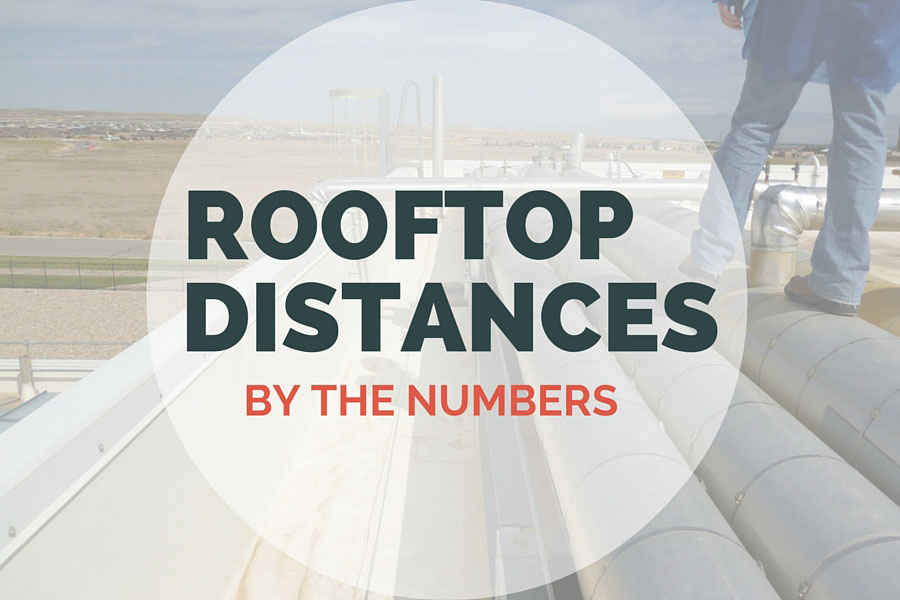Roof Distances By the Numbers

Updated on December 20, 2018 by Josh Borowiec
Rooftop fall protection seems to be one of the most confusing regulations.
Given the amount of different scenarios, it's easy to miss an important detail – or at least misinterpret one. So, here’s a quick and easy by-the-numbers guide for distances that come into play when discussing rooftop safety on flat or low slope rooftops.
Elevation Changes
Any break in elevation 19" or greater, OSHA requires a step or ladder to be provided.
Take a look at any changes in roof elevation that you have. Is there safe access to that elevation that does not require someone to step up/down 19" or more? Also, look at any obstacles on your roof. Are employees required to climb over them?
These changes in elevation can be solved with stairs, ladders, and crossover platforms. We recommend using stairs wherever feasible, as this typically provides the safest access for the worker.
Fall Distance (General Industry)
In general industry, any fall hazard 4’ or greater, requires protection.
Unlike the construction code, there are no exemptions to this rule. This could be the edge of the roof or any openings on the roof surface such as skylights and hatches.
Fall Distance (Construction)
When performing construction work, any fall hazard 6’ or higher requires fall protection.
There are a couple of exceptions to this rule that are covered later in this article. This applies to the same openings or edges noted in General Industry.
Minimum Edge Distance For Roofing Work
6’ is the minimum distance from the edge of the roof, or from a hole in the roof, at which you must erect a warning line during roofing work (if a warning line is your fall protection of choice).
Remember, a safety monitor, whose job it is to do nothing but ensure your personnel are not coming too close to the warning line, MUST be used in conjunction with a warning line. This solution is only allowable to those on a roof for the purposes of performing roofing work.
Controlled Access Zone
In addition, 6’ is also the minimum distance for control lines used in Controlled Access Zones for leading-edge work and precast work. The maximum distances vary and are listed later in this article.
Minimum Edge Distance for Mechanical Equipment
10’ is the minimum distance of a warning line from the edge of the roof, perpendicular to the travel of mechanical equipment. This refers specifically to the edge you are driving towards, not alongside. All of the same rules for warning lines as stated above still apply.
Minimum Edge Distance for Overhand Bricklaying
10’ is also the minimum distance from the edge for a control line when engaged in overhand bricklaying operations.
Maximum Edge Distance for Leading-Edge Work
25’ is the maximum distance a control line can be from the edge during leading edge work.
A leading-edge is essentially an unprotected edge that is "moving" as the building is being constructed. For example, as a roof is being constructed, each new piece of roof decking that is installed becomes the new edge.
Maximum Roof Width for Roofing Work
During roofing work, if your roof is no more than 50’ in width, you may utilize a safety monitor without a warning line.
This is the only situation in which this configuration is acceptable. If you are having trouble determining the width of your roof, you can refer to Appendix A to Subpart M of the Construction Regulations for guidance. Keep in mind, this only applies to roofing work.
Maximum Edge Distance for Precast Concrete
60’ (or half the length of the member) is the maximum distance a control line can be from the edge when erecting precast concrete members.
Important Reminder
There is no distance OSHA deems as a safe distance from a roof edge, so technically you should be protected at all times.
With that said, in numerous letters of interpretation, OSHA does view 50’-100’ as a potentially safe distance with the proper work rules and training in place. Be very careful leveraging this as an excuse out of protecting a hazard.
The concern here is that OSHA wants a distracted worker (the worker at highest risk) to be protected. If a worker is distracted, distance alone will not necessarily wake them up to their surroundings. A railing or warning line would.
Hopefully, this list can be used as a quick-reference guide for those readers involved in rooftop work. Remember that not all trades and tasks are created equal on a roof. Do not assume what is good for one group of employees or contractors is good for another.
Keep your numbers straight and keep your employees safe.



